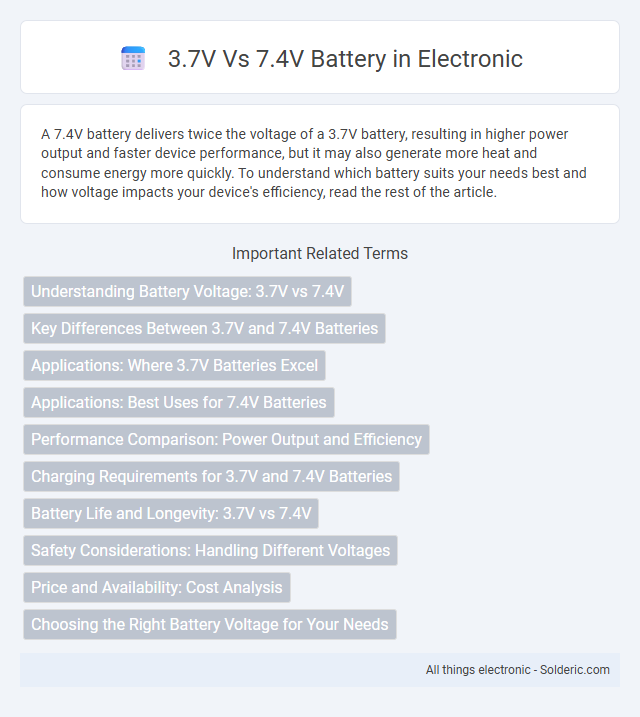A 7.4V battery delivers twice the voltage of a 3.7V battery, resulting in higher power output and faster device performance, but it may also generate more heat and consume energy more quickly. To understand which battery suits your needs best and how voltage impacts your device's efficiency, read the rest of the article.
Comparison Table
| Feature | 3.7V Battery | 7.4V Battery |
|---|---|---|
| Voltage | 3.7 Volts | 7.4 Volts (2 cells in series) |
| Capacity Range | Typically 500mAh to 3500mAh | Typically 1000mAh to 5000mAh |
| Application | Single-cell devices, small electronics | Higher power devices, RC models, drones |
| Energy Density | High energy density per cell | Higher total voltage, suitable for demanding loads |
| Weight | Lighter, single cell | Heavier, due to two cells |
| Charging Requirements | Single-cell charger, simpler | Balance charger required for 2 cells |
| Safety | Lower voltage risk | Higher voltage risk, needs proper handling |
Understanding Battery Voltage: 3.7V vs 7.4V
Battery voltage directly influences device performance and compatibility, with 3.7V and 7.4V being common nominal voltages for lithium-ion cells. A 3.7V battery typically represents a single lithium-ion cell, while a 7.4V battery consists of two cells connected in series, doubling the voltage output. Choosing between 3.7V and 7.4V batteries depends on the power requirements of the device, as higher voltage batteries like 7.4V provide increased energy capacity and longer run times but may require compatible electronics designed to handle the higher voltage.
Key Differences Between 3.7V and 7.4V Batteries
3.7V batteries are typically single-cell lithium-ion or lithium-polymer cells, offering lower voltage and lighter weight, making them ideal for compact electronics and low-power applications. 7.4V batteries consist of two 3.7V cells connected in series, doubling the voltage output to support higher power demands in devices like drones, RC cars, and power tools. Key differences include voltage capacity, power delivery, size, and compatibility with devices requiring specific voltage ratings for optimal performance and safety.
Applications: Where 3.7V Batteries Excel
3.7V batteries excel in compact electronic devices such as smartphones, wearable technology, and small drones due to their optimal balance of voltage and size. These batteries provide efficient energy storage ideal for gadgets requiring lightweight and portable power sources with moderate capacity. Their widespread use in single-cell lithium-ion configurations makes them a preferred choice for reliable, long-lasting performance in everyday consumer electronics.
Applications: Best Uses for 7.4V Batteries
7.4V batteries are ideal for applications requiring higher power output and longer runtime, such as RC cars, drones, and portable medical devices. Their increased voltage compared to 3.7V batteries provides better motor efficiency and faster acceleration in hobbyist electronics. Your choice of a 7.4V battery ensures enhanced performance in devices that demand more energy without significantly increasing size or weight.
Performance Comparison: Power Output and Efficiency
A 7.4V battery delivers higher power output than a 3.7V battery, enabling devices to achieve greater torque and faster speeds, ideal for high-performance applications. The increased voltage also enhances efficiency by reducing current draw for the same power demand, minimizing heat generation and extending battery life. However, 3.7V batteries offer better compatibility with low-voltage electronics and tend to weigh less, favoring portability over raw power.
Charging Requirements for 3.7V and 7.4V Batteries
Charging requirements for 3.7V batteries typically involve a single-cell lithium-ion or lithium-polymer charger with a constant current/constant voltage (CC/CV) profile, generally charging up to 4.2V per cell. In contrast, 7.4V batteries consist of two cells in series, requiring a balanced charger that ensures each cell is individually charged to prevent overcharging and maintain battery health. Proper charging protocols, including precise voltage thresholds and current limits, are crucial to maximize the lifespan and safety of both 3.7V and 7.4V lithium-based battery packs.
Battery Life and Longevity: 3.7V vs 7.4V
A 3.7V battery typically offers longer cycle life and slower degradation due to lower voltage stress on its cells, enhancing overall battery longevity. In contrast, a 7.4V battery, often composed of two 3.7V cells in series, provides higher power output but may experience faster wear and reduced lifespan under high load conditions. Optimal battery life depends on usage patterns, charging protocols, and thermal management for both voltage configurations.
Safety Considerations: Handling Different Voltages
Handling 3.7V and 7.4V batteries requires careful attention to voltage differences to prevent overcharging, overheating, or short circuits that can pose safety risks. You should use appropriate chargers and protective circuitry designed specifically for each voltage to ensure safe operation and long battery life. Proper insulation and avoiding physical damage are essential when working with these lithium-ion cells to minimize the risk of thermal runaway or fire hazards.
Price and Availability: Cost Analysis
3.7V batteries are generally more affordable and widely available due to their extensive use in consumer electronics like smartphones and small gadgets. In contrast, 7.4V batteries, often used in drones and higher-power RC devices, typically come at a higher price point reflecting their larger capacity and specialized application. Price variations also depend on factors such as battery chemistry, brand, and manufacturing scale, with 3.7V cells benefiting from economies of scale.
Choosing the Right Battery Voltage for Your Needs
Selecting the right battery voltage depends on your device's power requirements and efficiency goals. A 3.7V battery offers a balance of lightweight design and adequate power for low to moderate energy consumption applications, while a 7.4V battery provides higher voltage output suitable for more demanding electronic devices or faster performance needs. Evaluating your device's voltage compatibility and runtime expectations ensures optimal battery selection and enhances overall functionality.
3.7V vs 7.4V battery Infographic

 solderic.com
solderic.com